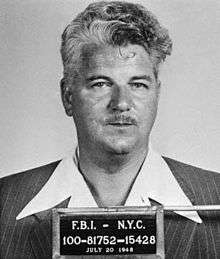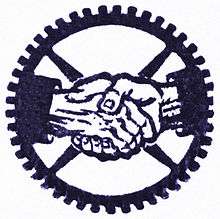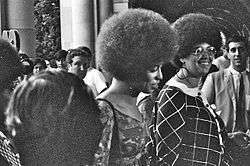John Abt
| John Abt | |
|---|---|
| Born |
John Jacob Abt May 1, 1904 Chicago |
| Died |
August 10, 1991 (aged 87) Hudson, New York |
| Nationality | American |
| Other names | "Amt" (VENONA) |
| Employer | AAA, La Follette Committee, United States Attorney General's office, CIO |
| Known for | membership in Ware Group, Perlo Group, IJA, NLG |
| Notable work | CIO union collective bargaining |
| Political party | Communist Party of the United States of America, American Labor Party, Progressive Party |
| Spouse(s) | Jessica Smith Ware, Vita Barsky |
John Jacob Abt (May 1, 1904 – August 10, 1991) was an American lawyer and politician. He spent most of his career as chief counsel to the Communist Party USA (CPUSA).[1]
Background
Abt was born on May 1, 1904 in Chicago, Illinois. He was a graduate of the University of Chicago, and from its law school.
Career
Abt practiced real estate and corporate law in Chicago from 1927 to 1933.[2]
Government (1933–1938)
Abt was the Chief of Litigation, Agricultural Adjustment Administration from 1933 to 1935, assistant general counsel of the Works Progress Administration in 1935 (where Lee Pressman was also working), chief counsel to Senator Robert La Follette, Jr.'s Committee from 1936 to 1937 and special assistant to the United States Attorney General, 1937 and 1938.[2]
Unions (1938–1948)
From 1938 to 1948, he worked at chief counsel of the Amalgamated Clothing Workers Union under Sidney Hillman, who hired him. By this time, the ACW had affiliated with the Congress of Industrial Organizations (CIO).[1]

In his memoir, Abt claimed that leaders of the Communist Party of the USA had inspired the idea of the CIO-PAC:
In 1943, Gene Dennis came to me and Lee Pressman to first raise the idea of a political action committee to organize labor support for Roosevelt in the approaching 1944 election. Pressman approached Murray with the idea, as I did with Hillman. Both men seized upon the proposal with great enthusiasm.[1]
Abt and Pressman became the CIO-PAC's co-counsels.[3] (Thus, in 1943, as American spy Elizabeth Bentley resurrected the Ware Group [of which Abt had been a member], Abt could not risk involvement with her or the group. Instead, the group reformed without him under Victor Perlo as the Perlo Group.[4])
By January 1946, he was also working as general counsel for the Congress of Industrial Organizations (CIO) and traveled to Russia with a CIO delegation, which included Lee Pressman.[5][6][7] (The CIO had long-term support from communists; in 1947, CIO leaders like Walter Reuther pushed out communist elements and again in 1949 after the CIO's merger with the American Federation of Labor [AFL] to form the AFL-CIO.)
Politics (1946–1948)

In September 1946, Abt appeared on the New York state ticket of American Labor Party candidates: Benjamin Fielding for Lieutenant Governor, Harry J. Chapman for State Controller, Joseph Lucchi for Attorney General, John T. Loughran for Chief Judge of the Court of Appeals, and John Abt for Associate Judge of the Court of Appeals.[8]
In October 1946, he (as CIO general counsel) joined other "liberal and progressive groups" in forming the new Progressive Party.[9]
Progressive Party (1948)
In February 1948, Abt left the Amalgamated and Pressman left the CIO to go work for the Progressive Party to support its presidential candidate, former Vice President Henry A. Wallace.[2][10] At the time, the Washington Post dubbed Abt, Lee Pressman, and Calvin Benham "Beanie" Baldwin (C. B. Baldwin) as "influential insiders"[11][12] and "stage managers"[13] in the Wallace campaign. He also supported the candidacy in New York of Vito Marcantonio, a leader of the American Labor Party.[14]
CPUSA Counsel (1950–1970s)
From 1951 to 1953, Abt joined Vito Marcantonio and Joseph Forer in defending the CPUSA on a charge from the McCarran Act.[2]
In January 1955 Abt defended Claude Lightfoot in Chicago, an African-American Communist on trial under the 1940 Smith Act for belonging to a group that advocates the overthrow of the US government. This trial marked the first time the government attempted to convict an individual solely as a member of a group conspiring against the nation, rather than for individual actions. Although Abt's short and simple defense did not succeed at this trial, Lightfoot's conviction was ultimately overturned by the US Supreme Court in 1964.
In 1960, Abt again defended the CPUSA before the U.S. Supreme Court on the constitutionality of the McCarran Act. In 1961, however, the Court sustained the section of the act requiring Communist-action organizations to register with the Government by a vote of five to four.[2]
During Lee Harvey Oswald's interrogation by the Dallas Police on the evening of 22 November 1963, pending his arraignment for the assassination of President John F. Kennedy, he requested the services of Mr. Abt:
I want that attorney in New York, Mr. Abt. I don't know him personally but I know about a case that he handled some years ago, where he represented the people who had violated the Smith Act, [which made it illegal to teach or advocate the violent overthrow of the U.S. government] . . . I don't know him personally, but that is the attorney I want. . . . If I can't get him, then I may get the American Civil Liberties Union to send me an attorney.
However, Abt and his wife had left New York City that day for a weekend at their cabin in Connecticut. He did not learn of Oswald's request until the following day. He told reporters that he had received no request either from Oswald or from anyone on his behalf to represent him, and so was in no position to give a definite answer. He said later that "if I were requested to represent him, I felt that it would probably be difficult, if not impossible, for me to do so because of my commitments to other clients."[15]
In 1965, the Supreme Court ruled that individuals may invoke their constitutional privilege against self-incrimination and refuse to register with the Government as members of the US Communist Party. Abt considered this decision as his greatest legal victory.[2]

Abt was one of the first attorneys to represent Angela Davis for her alleged involvement in the 1970 Marin County courthouse incident. Margaret Burnham worked with him and later wrote a foreword to his memoir.[1]
Alleged espionage
Ware Group (1934–1944)
Abt was also a member of the Ware Group, a covert organization of Communist Party operatives within the United States government in the 1930s, which actively aided Soviet intelligence by passing on government information, as well as furnishing assistance to members of the CPUSA. Abt's sister, Marion Bachrach, was also a member of the group. After the group's founder, Harold Ware, was killed in an automobile collision in 1935, Abt married Jessica Smith, Ware's widow.
In late 1943, Jacob Golos, who headed the CPUSA's secret apparatus, was referred to a spy ring of party members by General Secretary of the party, Earl Browder. This ring had been engaged for some time in espionage for Browder, and held regular clandestine meetings at Abt's apartment. In early 1944, Golos sent Elizabeth Bentley to make contact with the group at Abt's apartment. In attendance was Abt, Victor Perlo, Charles Kramer, Harry Magdoff and Edward Fitzgerald. They discussed paying party dues to Bentley, the various types of information each would be able to deliver, and the type of information other members not in attendance would also be willing to deliver.
In late 1943, the Federal Bureau of Investigation opened an investigation of Abt. Its surveillance showed frequent meetings in the early months of 1944 between Abt and a man then known as Alexander Stevens, one of the several pseudonyms used by the shadowy J. Peters, a party 'enforcer' who at one time headed the CPUSA's secret apparatus, and was involved in clandestine Soviet intelligence activities in the U.S., until his deportation to Hungary in 1948.
Hiss Case (1948)

In 1948, under subpoena before HUAC, Whittaker Chambers named Abt among members of the Ware Group. Abt refused to give testimony.[2][16]
(In 1996, it became known that Abt was referenced in Venona decrypts #588 KGB New York to Moscow, 29 April 1944 and #687 KGB New York to Moscow, 13 May 1944.[17])
Personal life and death
On March 14, 1937, Abt married Jessica Smith Ware, widow of Harold Ware; she died in 1983.[2][18]
Later, he married Vita Barsky.[2]
In 1984, on his 80th birthday, Abt admitted to being a long-time member of the CPUSA.[2]
On August 10, 1991, Abt died at the Columbia-Greene Medical Center in Hudson, New York from a stroke. He was 87.[2]
See also
References
- 1 2 3 4 Abt, John; Myerson, Michael (1993). Advocate and Activist: Memoirs of an American Communist Lawyer. Urbana, Illinois: University of Illinois Press. pp. 78 (Amalgamated), 99 (CIO-PAC), 273 (Angela Davis). ISBN 9780252020308.
- 1 2 3 4 5 6 7 8 9 10 11 Cook, Joan (13 August 1991). "John J. Abt, Lawyer, Dies at 87; Communist Party Counsel in U.S." New York Times. Retrieved 26 March 2017.
- ↑ Gall, Gilbert J. (1998). Pursuing Justice: Lee Pressman, the New Deal, and the CIO. SUNY Press. pp. 183–184.
- ↑ Olmsted, Kathryn S. (2002). Red Spy Queen: A Biography of Elizabeth Bentley. The University of North Carolina Press. p. 65. Retrieved 5 September 2017.
- ↑
"Union Leaders Reach Berlin". New York Times. 31 January 1946. p. 7.
|access-date=requires|url=(help) - ↑
Tower, Samuel A. (18 March 1946). "CIO Group for Aid to Russia as Way to Build Faith in U.S.". New York Times. pp. 1, 4, 5.
|access-date=requires|url=(help) - ↑
"CIO Officials Urge Closer Soviet Accord". Washington Post. 18 March 1946. p. 2.
|access-date=requires|url=(help) - ↑
Feinberg, Alexander (4 September 1946). "Democratic Deal Irks Labor Party: Move to Name Liberal for Bench May Cause Difficulties in Compact with ALP". New York Times. p. 15.
|access-date=requires|url=(help) - ↑
"Liberals Form Political Group for United, National Campaigns". New York Times. 16 October 1946. p. 1.
|access-date=requires|url=(help) - ↑
Loftus, Joseph A. (7 February 1948). "Pressman Quits $19,000 CIO Job To Back Wallace in Third Party". New York Times. p. 28.
|access-date=requires|url=(help) - ↑
Alsop, Joseph; Alsop, Stewart (25 July 1948). "Wallace Must Wonder Sometimes". Washington Post. p. B5.
|access-date=requires|url=(help) - ↑
Alsop, Joseph; Alsop, Stewart (28 July 1948). "Progressives Open Doors To Other Like-Minded Groups". Washington Post. p. B5.
|access-date=requires|url=(help) - ↑
Childs, Marquis (24 July 1948). "Calling Washington: Wallace's Stage Managers". Washington Post. p. 9.
|access-date=requires|url=(help) - ↑
Spargo, Mary (28 July 1948). "Progressives Open Doors To Other Like-Minded Groups". Washington Post. p. M1.
|access-date=requires|url=(help) - ↑ Testimony of John J. Abt, Warren Commission Hearings, vol. 10, p. 116.
- ↑ Chambers, Whittaker (1952). Witness. New York: Random House. pp. 467 (Ware Group), 624 (no testimony). LCCN 52005149.
- ↑ KGB agent & Earl Browder instruct Bentley on new recruits Archived 2013-09-18 at the Wayback Machine., Venona 687 New York to Moscow, 13 May 1944.
- ↑ "Federal Bureau of Investigation Documents – Files: Hiss/Chambers, 48 sections" (PDF). Education and Research Institute. Archived from the original (PDF) on 2016-06-28. Retrieved 31 July 2017.
Sources
- Abt, John; Myerson, Michael (1993). Advocate and Activist: Memoirs of an American Communist Lawyer. Urbana, Illinois: University of Illinois Press. ISBN 9780252020308.
- Chambers, Whittaker (1952). Witness. New York: Random House. p. 799. LCCN 52005149.
- John Earl Haynes and Harvey Klehr, Venona: Decoding Soviet Espionage in America, Yale University Press, 1999. ISBN 0-300-08462-5.
- Allen Weinstein and Alexander Vassiliev, The Haunted Wood: Soviet Espionage in America – The Stalin Era (New York: Random House, 1999).
- New York FBI report, 9 April 1944, John Jacob Abt FBI file 100-236194, serial 6.
- The Warren Commission Report, Volume X – Testimony of John J. Abt
